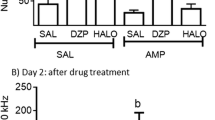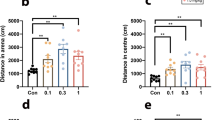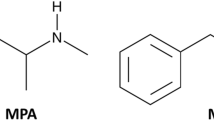Abstract
Dose-response relationships for onset, duration, and magnitude of 3-quinuclidinyl benzilate (QNB) on spontaneous motor activity (SMA) were studied in mice. QNB was administered SC immediately before 2-h test sessions in dose levels differing by a factor of 0.5 log (range 0.1–10.0 mg/kg). For the total activity session of 2 h, QNB had a biphasic effect on SMA; at a low dose (0.1 mg/kg) it decreased, and at moderate to higher doses (0.3–10.0 mg/kg) it increased SMA in a dose-related fashion. The onset and duration of the significant decreasing or increasing effects were also dose-dependent; at the low dose (0.1 mg/kg) it depressed SMA from 5 to 35 min postinjection, at moderate doses (0.3 and 1.0 mg/kg) it enhanced SMA from 5 to 45 min and 5 to 70 min, respectively, postinjection. At the higher doses (3.0 and 10.0 mg/kg) it increased SMA within 5 min and lasted for 100 and 120 min, respectively. The increase in SMA for the dose range from moderate to high doses of QNB (0.3–10.0 mg/kg) was linear with dose. In general, QNB appears to produce a biphasic effect on SMA responding in mice.
Similar content being viewed by others
References
Abood LG (1982) Anticholinergics. In: Hoffmeister F, Stille G (eds) Psychotropic agents, vol 3. Springer, Berlin Heidelberg New York, pp 331–347
Costall B, Hui SCG, Naylor RJ (1979) Hyperactivity induced by injection of dopamine into the nucleus accumbens: Actions and interactions of neuroleptic, cholinomimetic and cholinolytic agents. Neuropharmacology 18:661–665
DiChiara G, Porceddu ML, Vargiu L, Argiolas A, Gessa GL (1976) Evidence for dopamine receptors mediating sedation in the mouse brain. Nature 264:564–567
Hingtgen JN, Aprison MH (1976) Behavioral and environmental aspects of the cholinergic system. In: Goldberg AM, Hanin I (eds) Biology of cholinergic function. Raven, New York, pp 516–565
Iversen SD, Koob GF (1977) Behavioral implications of dopaminergic neurons in the mesolimbic system. Adv Biochem Psychopharmacol 16:589–595
Kuhar MJ (1978) Central cholinergic pathways: Physiological and pharmacological aspects. In: Lipton MA, Dimascio A, Killiam KE (eds) Psychopharmacology: A generation of progress. Raven, New York, pp 199–203
Liu WF, Hu NW, Chien TF, Beaton JM (1983) Effects of 3-quinuclidinyl benzilate on fixed-ratio responding and open field behavior in the rat. Psychopharmacology 80:10–13
Lyon M, Robbins T (1975) The action of central nervous system stimulant drugs: A general theory concerning amphetamine effects. In: Egman WB, Valzelli L (eds) Current developments in psychopharmacology, vol 2. Spectrum, New York, pp 79–163
Skirboll LR, Grace AA, Bunney BS (1979) Dopamine auto- and postsynaptic receptors: Electrophysiological evidence for different sensitivity to dopamine agonist. Science 206:80–82
Strömbon LL (1976) Catecholamine receptor agonists: Effects on motor activity and rate of tyrosine hydroxylation in mouse brain. Naunyn Schmiedebergs Arch Pharmacol 292:167–176
Author information
Authors and Affiliations
Rights and permissions
About this article
Cite this article
Liu, WF., Hu, NW. & Beaton, J.M. Biphasic effects of 3-quinuclidinyl benzilate on spontaneous motor activity in mice. Psychopharmacology 84, 486–488 (1984). https://doi.org/10.1007/BF00431454
Received:
Accepted:
Issue Date:
DOI: https://doi.org/10.1007/BF00431454




